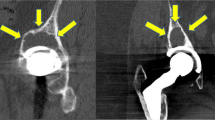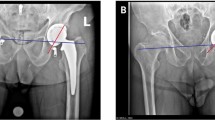Abstract
We postulated that certain patient characteristics have different effects on early THA component loosening. With two matched case-control studies we assessed 3,028 cups and 5,224 stems. Loosening was defined using signs of mechanical component failure on routine follow-up radiographs or revision for aseptic loosening. Women and men had similar cup-loosening odds, but women had lower odds for stem loosening (p < 0.0001). Odds for cup loosening decreased by 2.1% per additional year of age (p = 0.0004), those for stem loosening by 2.4% (p < 0.0001). Each additional kilogram of weight decreased cup loosening odds by 1.3% (p = 0.0051). Each additional unit of BMI increased stem loosening odds (p = 0.0109). Charnley classes B and C were protective factors against loosening of both components. There were no risk differences for the various main diagnoses. Certain patient characteristics differently affected early cup and stem loosening, although some characteristics had the same protective or harmful effect on component survival.
Résumé
IO-10-06-555.R1. A partir de l’hypothèse que certaines caractéristiques des patients avaient un effet sur les descellements précoces des prothèses de la hanche, nous avons étudié 3028 cupules et 5224 tiges fémorales dans le cadre d’une étude controlée. Le descellement a été défini par des anomalies radiographiques ou l’existence d’une reprise pour descellement aseptique. Les hommes et les femmes avaient un taux similaire de descellement cotyloidien mais les femmes avaient un taux de descellement de tige plus faible (p<0,0001). La fréquence des descellements cotyloidiens diminuait de 2,1% par année d’âge (p=0,0004), et celle des descellements de tige de 2,4% (p<0,0001). Chaque kilog de poids supplémentaire diminuait de 1,3% les descellements cotyloidiens (p=0,0051). Chaque unité supplémentaire de BMI augmentait le descellement de la tige (p=0,0109).Les classes B et C de Charnley étaient des facteurs protecteurs du descellements des deux composants.. Il n’y avait pas de différence de risque entre les principaux diagnostics. Les caractéristiques des patients affectent de façon différente les descellements précoces et certaines caractéristiques sont protectrices ou nuisibles vis à vis de la survie des composants.
Similar content being viewed by others
References
Ahnfelt L, Herberts P, Malchau H, Andersson GB (1990) Prognosis of total hip replacement: a Swedish multicenter study of 4,664 revisions. Acta Orthop Scand Suppl 238:1–26
Berry DJ, Harmsen WS, Cabanela ME, Morrey BF (2002) Twenty-five-year survivorship of two thousand consecutive primary Charnley total hip replacements: factors affecting survivorship of acetabular and femoral components. J Bone Joint Surg Am 84:171–177
Boeree NR, Bannister GC (1993) Cemented total hip arthroplasty in patients younger than 50 years of age: ten- to 18-year results. Clin Orthop 287:153–159
Bulstrode C (1987) Keeping up with orthopaedic epidemics. Br Med J (Clin Res Ed) 295:514
Carlsson AS, Gentz CF, Lindberg HO (1983) Thirty-two noninfected total hip arthroplasties revised due to stem loosening. Clin Orthop 181:196–203
Carlsson AS, Gentz CF (1980) Mechanical loosening of the femoral head prosthesis in the Charnley total hip arthroplasty. Clin Orthop 147:262–270
Cornell CN, Salvati EA, Pellicci PM (1985) Long-term follow-up of total hip replacement in patients with osteonecrosis. Orthop Clin North Am 16:757–769
DeLee JG, Charnley J (1976) Radiological demarcation of cemented sockets in total hip replacement. Clin Orthop 121:20–32
Dutton RO, Amstutz HC, Thomas BJ, Hedley AK (1982) Tharies surface replacement for osteonecrosis of the femoral head. J Bone Joint Surg Am 64:1225–1237
Fender D, van der Meulen JH, Gregg PJ (2003) Relationship between outcome and annual surgical experience for the charnley total hip replacement. Results from a regional hip register. J Bone Joint Surg Br 85:187–190
Hedley AK, Kim W (1983) Prosthetic replacement in osteonecrosis of the hip. Instr Course Lect 32:265–271
Inoue K, Ushiyama T, Tani Y, Hukuda S (1999) Sociodemographic factors and failure of hip arthroplasty. Int Orthop 23:330–333
Kavanagh BF, Wallrichs S, Dewitz M, Berry D, Currier B, Ilstrup D, Coventry MB (1994) Charnley low-friction arthroplasty of the hip. Twenty-year results with cement. J Arthroplast 9:229–234
Kavanagh BF, Ilstrup DM, Fitzgerald RH Jr (1985) Revision total hip arthroplasty. J Bone Joint Surg Am 67:517–526
Kobayashi S, Eftekhar NS, Terayama K (1994) Predisposing factors in fixation failure of femoral prostheses following primary Charnley low friction arthroplasty: a 10- to 20-year follow-up study. Clin Orthop 306:73–83
Lachiewicz PF, McCaskill B, Inglis A, Ranawat CS, Rosenstein BD (1986) Total hip arthroplasty in juvenile rheumatoid arthritis: two to eleven- year results. J Bone Joint Surg Am 68:502–508
Malchau H, Herberts P, Ahnfelt L (1993) Prognosis of total hip replacement in Sweden. Follow-up of 92,675 operations performed 1978–1990. Acta Orthop Scand 64:497–506
Noble PC, Box GG, Kamaric E, Salama JK, Ochi T, Tullos HS (1995) The effect of aging on the shape of the proximal femur. Clin Orthop 316:31–44
Paterson M, Fulford P, Denham R (1986) Loosening of the femoral component after total hip replacement: the thin black line and the sinking hip. J Bone Joint Surg Br 68:392–397
Röder C, Eggli S, EL-Kerdi A, Müller U, Ambrose T, Röösli E, Busato A, Aebi M (2003) The international documentation and evaluation system (IDES) - ten years experience. Int Orthop 27:259–261
Röder C, Parvizi J, Eggli S, Berry DJ, Müller ME, Busato A (2003) Demographic factors affecting long-term outcome of total hip arthroplasty. Clin Orthop 417:62–73
Schurman DJ, Bloch DA, Segal MR, Tanner CM (1989) Conventional cemented total hip arthroplasty: assessment of clinical factors associated with revision for mechanical failure. Clin Orthop 240:173–180
Sutherland CJ, Wilde AH, Borden LS, Marks KE (1982) A ten-year follow-up of one hundred consecutive muller curved-stem total hip-replacement arthroplasties. J Bone Joint Surg Am 64:970–982
Surin VV, Sundholm K (1983) Survival of patients and prostheses after total hip arthroplasty. Clin Orthop 177:148–153
Young NL, Cheah D, Waddell JP, Wright JG (1998) Patient characteristics that affect the outcome of total hip arthroplasty: a review. Can J Surg 41:188–195
Author information
Authors and Affiliations
Corresponding author
Rights and permissions
About this article
Cite this article
Röder, C., Eggli, S., Münger, P. et al. Patient characteristics differently affect early cup and stem loosening in THA: a case-control study on 7,535 patients. International Orthopaedics (SICO 32, 33–38 (2008). https://doi.org/10.1007/s00264-006-0291-8
Received:
Revised:
Accepted:
Published:
Issue Date:
DOI: https://doi.org/10.1007/s00264-006-0291-8




